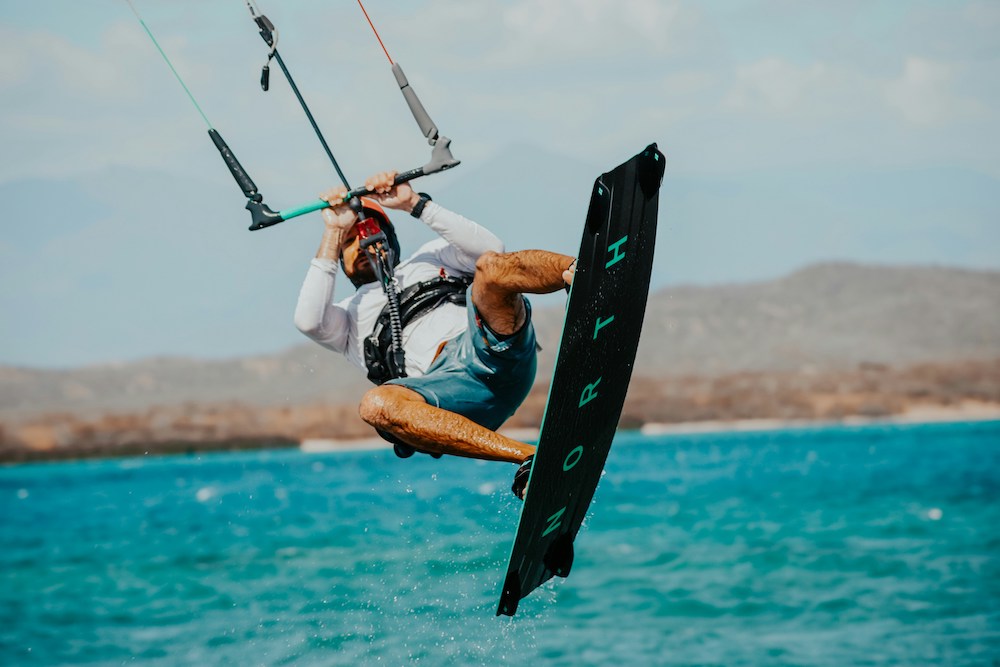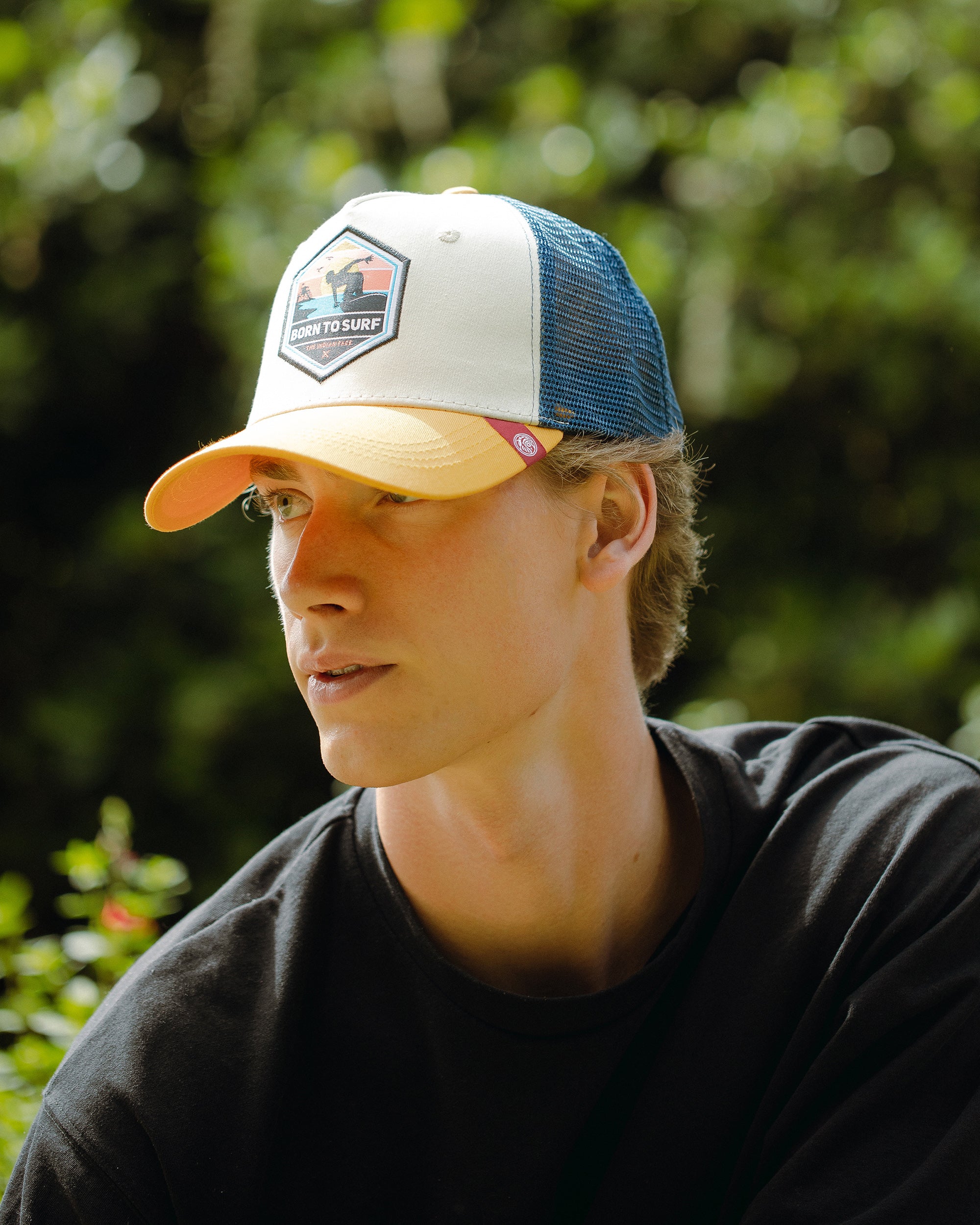Kitesurfing, also known as kiteboarding, is a water sport that has gained significant popularity in recent decades. It combines the excitement of surfing with the power of the wind and the versatility of a kite, offering adrenaline lovers a unique experience on the waves. From humble beginnings to becoming a global phenomenon, kitesurfing has captivated people of all ages and abilities, attracting adventurers looking to challenge the limits and feel the freedom that only the sea can offer.
Origins and evolution: from inflatables to an elite sport
The history of kitesurfing is a fascinating journey that has seen how an innovative idea became a globally recognized sport. The Legaignoux brothers, in the 1970s, laid the foundation by developing inflatable kites for traction in water sports. These first prototypes, although rudimentary compared to modern kites, marked the beginning of a revolution in the world of extreme sports.
However, it wasn't until the 1990s that kitesurfing really took off. With the introduction of boards designed specifically for kiteboarding and significant improvements in kite design, the sport took on a new dimension. Kites became safer and easier to control, allowing riders to explore new possibilities on the water. This period of rapid technological development laid the foundation for the kitesurfing boom that would follow.

Since then, kitesurfing has undergone constant evolution. Kites have become more efficient and maneuverable, thanks to advances in materials and design. The boards have evolved to adapt to different riding styles, from freestyle to
Today, kitesurfing is practiced all over the world, from the tropical beaches of Hawaii to the frozen lakes of Canada. The kitesurfing community is diverse and passionate, made up of people of all ages and abilities who share a passion for adventure and challenge. Whether they are looking for the thrill of riding giant waves in the ocean or simply enjoying a lazy day on the water, kitesurfers find this sport a unique way to connect with nature and release their free spirit.
Equipment and techniques: ride the waves safely
Kitesurfing is an exciting sport that combines the power of the wind with the rider's ability to glide over the waves. To master this art, it is essential to understand the necessary equipment and techniques required to successfully navigate the water.
Basic kitesurfing equipment includes a series of essential elements that allow the rider to control the kite and glide on the water surface with ease and safety.
- The kite: which acts as the engine of the sport, generating the traction necessary to propel the rider through the water. Kites come in a variety of shapes and sizes, each designed to suit different wind conditions and riding styles. From high speed kites for high wind conditions to larger, more stable kites for light wind days, riders have a wide range of options to choose from depending on their preferences and abilities.
-
Board: in this case, this is a board designed specifically for kitesurfing. These boards vary in size and shape, from short, agile boards ideal for freestyle maneuvers to long, streamlined boards designed for
freeride and wave surfing. Board choice depends on the rider's riding style and the water conditions they plan to ride. - Harness: To control the kite and stay connected to it while riding, riders use a harness that fastens around the waist or hips. The harness distributes the force of the wind over the rider's body, allowing them to maintain balance and control the direction of the kite more easily. Additionally, they have a control bar connected to the kite that gives the rider the ability to steer and adjust the power of the kite while sailing.

Kitesurfing is practiced in a wide variety of environments, from oceans and lakes to rivers and even snow-covered areas. Riders use the kite to generate traction and speed, gliding over the surface of the water with grace and style. Successful sailing on the water requires proper technique which includes the ability to control the kite in all wind conditions and master a variety of maneuvers such as turns, jumps and tricks.
Safety is a key consideration when kitesurfing, and riders should be familiar with basic safety measures, such as self-rescue capability and the ability to quickly release the kite in an emergency. Additionally, it is important to respect local rules and regulations, as well as share the water safely with other users, such as swimmers and boaters.
Kitesurfing is an exciting sport that offers a unique combination of speed, skill and freedom on the water. With the right equipment and proper technique, riders can enjoy an unparalleled experience as they ride the waves and immerse themselves in the beauty and excitement of kitesurfing.
Benefits and challenges: learn everything about kitesurfing
Kitesurfing, in addition to being an exciting aquatic activity, offers a wide range of physical and mental benefits for those who immerse themselves in this exciting sport. At the same time, it presents unique challenges that require perseverance and dedication to overcome. We will explore both the benefits and challenges of kitesurfing below.

As benefits we find:
- Complete exercise: Kitesurfing is an excellent cardiovascular exercise that involves the entire body. From the muscles in your arms and legs to your core and back, every part of your body works together to maintain balance, control the kite, and glide over the waves. This activity effectively strengthens muscles and improves endurance.
- Mental agility and coordination: To successfully kitesurf, a high level of concentration and coordination is required. Riders must be able to anticipate and react quickly to changes in wind and water conditions, as well as coordinate the movement of the kite and board with pinpoint precision. This demand for mental agility and coordination helps improve reaction capacity and concentration in other areas of life.
- Connection with Nature: Kitesurfing allows riders to connect intimately with nature while enjoying the aquatic environment. The sensation of gliding over the waves driven by the wind provides a unique experience of freedom and serenity, which rejuvenates the spirit and relieves stress.
And as challenges we can find:
- Learning Curve: For beginners, mastering kite and board control can be a considerable challenge. It requires time, patience, and constant practice to acquire the skills necessary to successfully navigate the water. Riders must be prepared to face the learning curve and overcome obstacles that may arise on the path to mastery of the sport.
- Safety and weather conditions: Kitesurfing is a sport that is highly dependent on weather conditions, such as wind and tides. Riders should be aware of changes in weather and adjust their riding accordingly to ensure a safe experience. Additionally, learning to navigate safely in different wind and wave conditions is essential to avoid accidents.
- Risks and Precautions: Although kitesurfing is generally safe when practiced correctly, there are inherent risks associated with the sport. Riders should be aware of these risks and take appropriate precautions to minimize them, such as wearing appropriate safety equipment, receiving appropriate training, and practicing self-rescue maneuvers.

Kitesurfing offers a unique combination of physical, mental and emotional benefits for those who venture into this exciting sport. However, it also presents challenges that require determination and commitment to overcome. With the right preparation and the right attitude, kitesurfing can become a rewarding and enriching experience that provides a deep connection with nature and an incomparable feeling of freedom on the water.
Safety and responsibility with the environment
Safety and responsibility are fundamental pillars in the practice of kitesurfing, a sport that combines excitement and freedom in the water with the need for caution and respect for the natural environment and other water users. These two essential facets of kitesurfing are explored in greater depth here.
- Safety Priority
Kitesurfing involves the use of equipment and is subject to environmental conditions that can be dangerous if not handled properly. Therefore, it is imperative that riders prioritize safety at all times. This involves following safety guidelines established by organizations such as the International Kitesurfing Association (IKO), which provide standards and recommendations for the safe practice of the sport. These guidelines include advice on choosing the right equipment, evaluating wind and water conditions, and taking additional precautionary measures in potentially risky situations.
Riders should also be aware of their surroundings and water conditions at all times, especially when riding in congested areas or in extreme wind conditions. Maintaining clear communication with other water users and following priority and right-of-way rules helps prevent accidents and ensure a safe experience for everyone.
- Environmental Responsibility
In addition to worrying about their own safety, riders also have the responsibility to protect the environment and preserve the natural environments where they kitesurf. This includes avoiding protected areas, such as nature reserves or seabird nesting areas, where practicing the sport can cause irreparable damage to the ecosystem.
Likewise, riders must be aware of their environmental footprint and take measures to minimize their impact on the environment. This includes picking up any trash or debris they find on the beach or in the water, and adopting sustainable boating practices that minimize coastal erosion and water pollution.

By kitesurfing in a responsible and environmentally friendly manner, riders can contribute to the preservation of the natural environments they enjoy so much and ensure that the sport remains a safe and sustainable activity for future generations. Environmental responsibility is an integral component of kitesurfing ethics and should be a central consideration in all riders' practices and decisions.
Enjoy the freedom of the sea from the top of the wave
Kitesurfing is more than a sport; It is a way of life that embodies freedom, excitement and connection with nature. From its modest beginnings to its current status as one of the most exciting water sports in the world, kitesurfing has inspired people of all ages and abilities to push the limits and explore new frontiers on the water.
Whether surfing giant waves in the ocean or performing stunts on a calm lake, kitesurfing offers an incomparable experience that leaves a lasting impression on those who dare to try it. With its unique combination of skill, strength and passion, kitesurfing continues to attract a global community of passionate riders who find the sea a perfect setting to unleash their adventurous spirit.
FREQUENTLY ASKED QUESTIONS ABOUT KITESURFING
What is kitesurfing?
Kitesurfing is a water sport that combines navigation with a traction kite and a specialized board. Riders use the force of the wind to glide over the water and perform exciting maneuvers.
What is the basic equipment needed to practice kitesurfing?
Basic equipment includes a kite, a board, a harness and a control bar. The kite generates traction, the board provides flotation and direction, the harness connects the rider to the kite, and the control bar allows the kite to be steered.
Where can you kitesurf?
Kitesurfing can be practiced in a variety of environments, including beaches, lakes, rivers and lagoons. Riders should choose locations with sufficient space and safe riding conditions, and respect local regulations and water priority rules.
What is the best time of year to kitesurf?
The best time to kitesurf depends on factors such as geographic location and local weather conditions. In general, the spring and summer months tend to offer more consistent winds and more favorable conditions for kitesurfing.

















































